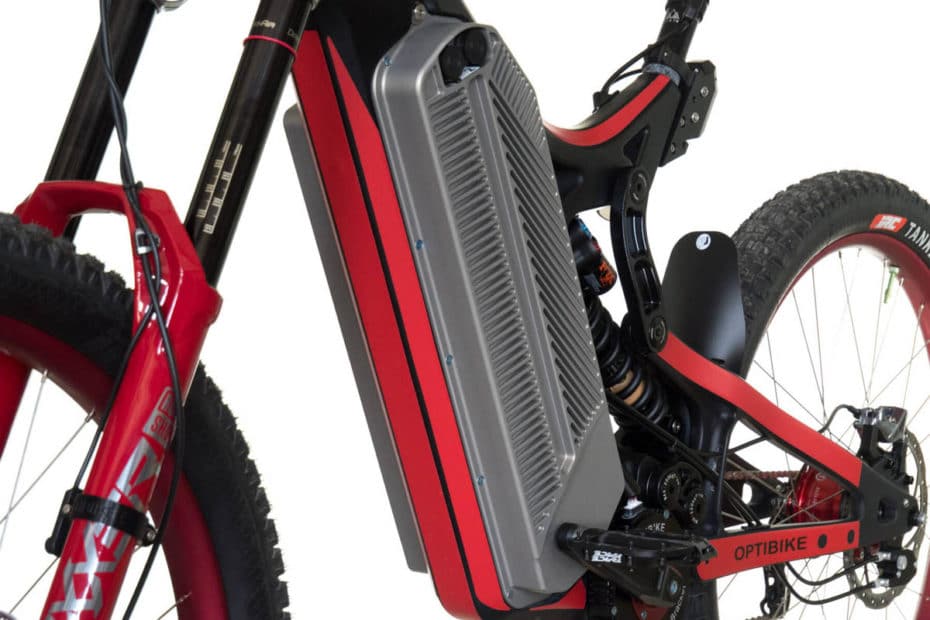One of the reasons why ebikes are so fascinating to many is the enormous variety of bikes that are now on the market. Some of them simply show where the limits of what is possible have shifted in the course of the last few years. Whether this could be a solution for the majority of interested people is secondary at best. The R22 Everest from Optibike belongs to this category. According to the US manufacturer, it is the only bike you could ride to the summit of Mount Everest. If there were a road leading there.
Well, almost every manufacturer could claim this assumption. In the case of the R22 Everest, however, you could take plenty of run-up to the summit. The battery of this ebike promises a range of a fabulous 480 kilometres or 300 miles. It draws its endurance from a total of 3,260 watt-hours of energy. In comparison, even the 800 watt-hours of the new EnergyPak Smart from Giant or the 750 watt-hours of the current PowerTube for the Smart System from Bosch seem almost dinky.
Dual Battery in disguise
A closer look puts the whole thing into perspective a little. The Optikbike battery is basically two separate batteries, each with a capacity of 1,630 watt-hours. The ebike system only accesses these separately. A simple switch allows you to select whether the current should flow from battery 1 or battery 2. The housing, however, is a common one. This means that you can remove the battery from the ebike as a single unit. Provided you first loosen the three massive M6 screws that hold it in the frame.
A little strength training before removing the battery won’t hurt. After all, the battery weighs an impressive 16.3 kilograms. The fact that it’s not even more is due to the carbon housing. Jim Turner, founder and at the same time chief developer at Optibike, apparently did not want to completely neglect the question of weight. The former motocross professional is not only a two-time US champion, but also holds a degree from the renowned Stanford University. Accordingly, there is a great deal of technical know-how in the bike. In addition to the battery, other essential parts such as the carbon frame, the motor, the rear triangle and the front headlight were developed entirely on the basis of his own ideas. By the way, Optibike still assembles the bikes by hand at its headquarters in Colorado.
In the fast lane
The motor’s figures are no less impressive. In continuous operation it produces 1,700 watts, rising to 2,500 watts at its peak. At this point, the question of whether this ebike is approved for riding in Europe is superfluous ? Especially when you look at the speed up to which the motor supports you. Of course, that’s not the 25 km/h we’re used to. Nor is it 45 km/h, which is the upper limit for an speed pedelec. On the R22 Everest, riders have to be prepared for almost 58 km/h, i.e. 36 miles per hour. So it’s helmet on and visor down. Especially since the torque of 190 Newton metres ensures a good deal of liveliness.
Typical for an ebike aimed at the North American market, the motor on the R22 Everest is controlled by a throttle grip on the handlebars. This proves to be an advantage, especially off-road, in situations where the pedalling motion involves the risk of getting stuck on obstacles with the crank and pedals.
High-quality “sheet anchor”
Conversely, this means that you do not benefit from the motor assistance when pedalling alone. To ensure that the bike’s 42 kilograms can still be moved reasonably, Optibike has chosen a Rohloff E-14 Speedhub. Its gear range of 526 percent, together with the 14 gears, enables you to get from A to B even if the battery should unexpectedly be exhausted.

Jim Turner obviously has a lot of fun on the ebike he developed, even with a bicycle trailer in tow.
Suitable for any terrain
This model is designed as a fully-fledged e-mountain bike. The rear suspension travel is 200 millimetres. Nothing precise is said about the dual crown suspension fork. From a distance, however, the measurement here seems to be quite similar. The virtual pivot point of the rear suspension is close to the damper. The actual rear struts are rigid in order to be able to tame the forces of the motor.
The view ahead is illuminated by an optional front headlight. Compared to European standards, this too seems almost monstrous. According to Optibike, the lamp emits 2,700 lumens. There is no mention of a low beam. One can only hope that the riders take enough time to adjust the light correctly. Otherwise, not only some elks will blink in irritation.
Let’s cross
Optibike founder Jim Turner wanted the R22 Everest to feel as dynamic as a motocross bike. It should just be a little lighter than such a bike. Just like the riders who can do without all the protective gear. Maybe you’ll think again about the protective gear if you ever get the chance to ride this bullet.
Pictures: Optibike LLC









The R22 Everest is totally AWSOME !!
If you bought the non-proprietary components by themselves it would be over $9k. Then a custom frame, custom motor and that battery.
Sounds great, possible to buy in Europe (Sweden)?
Hello Gunnar,
As far as we know, Optibike has already sold products to more than 30 countries. If you want to know whether they also sell the bike to Sweden, you better contact Optikbike support directly.
Cheers, Matthias